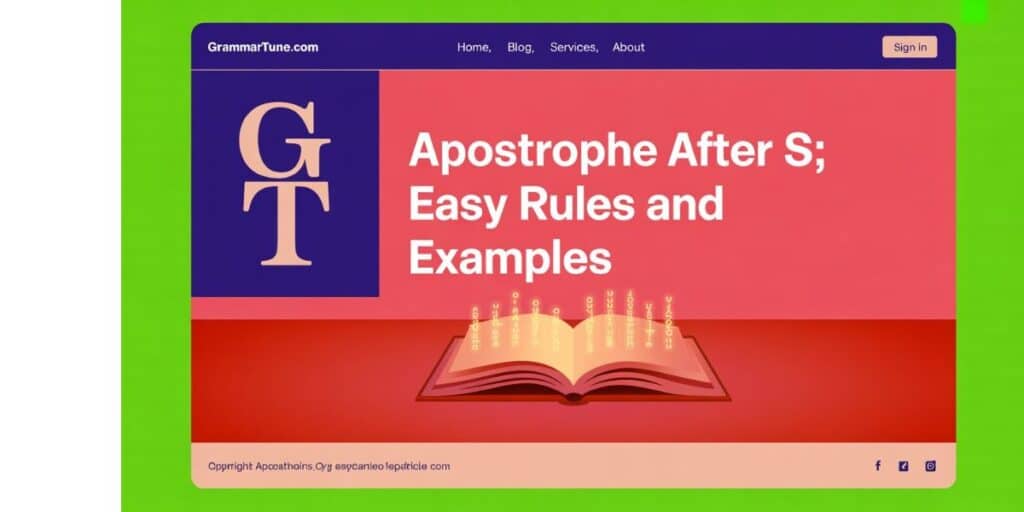Struggling with where to put the apostrophe after S? You’re not alone—this tiny mark trips up even seasoned writers.Walk you through the simply easy rules and very explicit examples that make it impossible for you to ever doubt again.
What Is an Apostrophe?
An apostrophe denotes possession or consists in the formation of a contraction. This indicates that something belongs to someone or something. For instance, the phrase “the dog’s bone” indicates that the bone belongs to the dog.
Must read: Antithesis vs Juxtaposition: What’s the Difference?
Apostrophe After “S” – The Simple Rule
For plural nouns, if they end in s then to show possession just add apostrophe after s .For example ,the dogs‘ toys means toys belong to dogs. It simplifies writing and eliminates unnecessary apostrophes.
Apostrophe Usage: Before ‘S’ vs After ‘S’
We use the apostrophe before s for singular possessive nouns as in the cat’s whiskers. When plural possessive nouns end with s, the apostrophe will follow the s, as in the cats’ whiskers.This distinction shows ownership clearly.
When to Use the Apostrophe After “S”?
An apostrophe is used after the s when a plural noun that already ends in s is showing possession. Teachers’ lounge, for example, shows that the lounge belongs to more than one teacher, thus supporting grammatical consistency in the system.
Apostrophe Placement Rules
The placement of apostrophe is thus decided after ascertaining whether the subdivided noun is singular or plural. A singular possessive noun gets an ‘s while a plural possessive noun gets only an apostrophe, provided it ends with an s. This mechanism will maintain clear communication.
What Is the Possessor?
The possessor is the noun that owns or possesses something. In “the girl’s book”, the girl is the possessor. Knowing the possessor helps in putting the apostrophe in the right place.
Only the Possessor Matters
The focus is on the possessor for determining apostrophe placement. How many things one is possessing does not matter. An example would be “the boy’s toys,” which refers to toys for one boy, gracelessly ignoring the number of toys.
You will like: Than vs Then: Avoiding Common Mistakes in English
Exceptions
There are some exceptions to the general rules regarding apostrophes. Singular proper nouns ending in s may take either ‘s or just an apostrophe, based on the style guide being followed. Always refer to the relevant style guide for consistency.
Singular Nouns Ending in “S”
In the English language, singular nouns ending in apostrophe-s form the possessive case. An example of this might be “the class’s project”, implying that the project belongs to the class; still other guides may allow simply an apostrophe.
Proper Nouns with “S”
Proper nouns ending in s may govern the same behaviour as other singular nouns. For example, the book belongs to James, whose book is James’s. Again, the preferred usage differs from style guide to style guide.
Tricky “S” Situations: Words Like “Plus” and Initials
A word like “plus,” “because,” and “unless” do not get an apostrophe whether or not they contain an “s.” Almost in line, initials convey their possession by acquiring only an apostrophe, e.g., in “the BBC’s report.”
Common Mistakes to Avoid (and How to Fix Them!)
Thus write “the teacher’s room,” so plural possessive nouns do not take an extra s. Confuse possessives with contractions; “it is” means “it is” while “its” shows possession. Attention to these fine prints improves exactness.
Tips and Tricks for Remembering the Apostrophe After “S”
To remember the wrong apostrophe using after s, think of the word s to mean plurality. If the noun is a plural and ends with an ‘s’, simply add an apostrophe. This mental shortcut simplifies the rule.
Using Apostrophes After “S” in Different Contexts
Use apostrophes after s differs with context, be they academic writing, journalistic, etc. Always follow the style guide appropriate to your context.
Polish Your Writing: Putting Apostrophes to Work
Knowing how to use and apply apostrophes in every case, especially those concerning nouns that end with an s, will undoubtedly refine your work style and reading flow.
It helps, therefore, to know when to apply the rules and when exceptions come into play. This will definitely bring confidence and clarity to your writing.
You will like: Motif vs Theme: Clarifying the Confusion
FAQ’S
When do I add just an apostrophe after a word ending in S?
You add only an apostrophe when the word is plural and ends in s, like in “dogs’ toys” or “students’ books.”
Do I use an apostrophe for singular nouns ending in S?
Yes, usually. For example, “Chris’s car” is correct in most styles. But some style guides, like AP, prefer just “Chris’ car.”
Can I use apostrophes to make words plural?
No. Apostrophes are never used to form plurals. Writing “apple’s” for more than one apple is incorrect.
What’s the difference between its and it’s?
“It’s” means “it is” or “it has” (a contraction). “Its” shows possession, like “The dog wagged its tail.“
Do I need to follow a style guide?
Yes, especially in professional or academic writing. Style guides like APA, MLA, or Chicago can have different rules on apostrophes, especially with proper nouns ending in s.
Conclusion
The use of the apostrophe after S is not at all baffling. You can be lucid and confident in writing by remembering the very simple rule – after plural nouns ending in s, just add an apostrophe.
Always identify the possessor, follow your preferred style guide, and stay alert for exceptions. Whether it’s James’s book or teachers’ lounge, these examples will keep you clear from such mistakes.
So, remember these easy rules, and you will be alright with punctuation, thus giving your writing a more professional and polished look.

Joulia, a seasoned wordsmith and grammar enthusiast, brings over a decade of blogging expertise to Grammar Tune. With a keen eye for linguistic precision and a passion for making complex grammar concepts accessible, he has helped thousands of readers enhance their writing skills. His engaging teaching style and practical approach to language learning have made him a trusted voice in the online grammar community.







